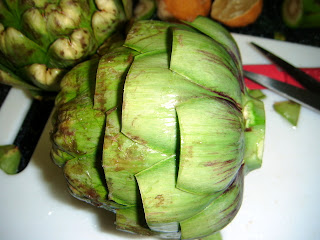If you're new to artichokes, there are a few things you should know about this flower. When buying artichokes, carefully lift the petals from the sides, looking inside for any bugs or bug... residue. There's nothing worse than getting a nasty artichoke. They should look clean, like this:
The petals have a sharp spiny bit at the very tip, just in the middle. You're going to want to be careful handling these. As you trim the tips from the petals, gently lift each petal by the side edge to avoid being jabbed by the thorn. They're nasty little buggers, and the bigger the artichoke, the bigger the thorns are.
Timewise, you're going to want to prep the artichokes after you make the duxelles. You don't need anything fancy to make these, but a mini food processor will speed things up considerably.
Duxelles
1- 8 ounce package sliced white mushrooms, minced very fine
1/3 cup very finely minced sweet onion
2 Tbsp unsalted butter
1/2 tsp salt
1/2 tsp ground black pepper
1/2 tsp dried thyme leaves
2 Tbsp. red or white wine
1/2 cup fresh breadcrumbs (if you use the prepackaged stuff , reduce this to 1/4 cup)
Over medium-high heat, melt the butter in a heavy-bottomed saute pan. Add onion and saute until translucent. Add the mushrooms, salt, pepper, and thyme, stirring to combine. The mushrooms will release a liquid after a minute or two:
Stir in the wine, and continue to stir frequently until the mixture is dry and caramelized. Remove about a quarter of the mushroom mixture from the pan and reserve for another use. Add the breadcrumbs to the pan and cook for another 2-3 minutes. Remove from heat and allow to cool.
After the breadcrumbs have been added. See the difference?
Prepping the Artichokes:
You'll need:
2 large artichokes
1 lemon (optional)
1/2 cup water
microwave-safe shallow glass dish (ie. pie plate or casserole dish)
microwave-safe cling film, or a microwave-safe bowl that will fit over the plate you are using
Duxelles recipe, above
The first thing you're going to want to do is wash these. Sometimes they're coated with a waxy coating that you'll need a soft scrub brush to take off (I use an extra-soft toothbrush). You also may like to have a lemon handy to keep the cut parts from browning, but it isn't absolutely necessary. If you don't have one, no worries.
Be mindful of the thorns, take the artichoke from the stem, turn it upside down, and brush downward under running water. We'll save rinsing the inside until after the petals have been trimmed.
Once rinsed, pull the tiny petals at the very bottom off. My mom pulls the entire bottom row of petals off after this step, but I don't find it necessary unless they're in bad condition. Beginning on the bottom row of petals, take a pair of kitchen shears (or scissors), and snip the top third of the petal off. Continue doing so until you are in the center of the artichoke and you just cannot pull any more petals apart.
Once trimmed, rinse the artichoke under running water, right side up. Gently separate the petals so the water can rinse any trapped dirt. Shake them over the sink to dry.
Slice the stem off of the artichoke, as straightly as possible, so they can stand up in the plate without leaning over. Place one of the two artichokes in a microwave-safe, shallow glass plate (I use a Pyrex pie plate).
Using your fingers, gently pry a petal open, and stuff the opening with a pinch of duxelles. Continue until all of the cut petals have been stuffed (except for the tightly-packed petals in the very middle; don't worry about those). Repeat with the second artichoke. If you have duxelles/breadcrumb mixture left over at this point, continue stuffing the petals until you don't have any more stuffing. Place both artichokes in the dish, and pour the water into the dish (NOT over the artichokes).
Cover the dish with the cling film. If you're using the bowl, put the dish into the microwave and then cover with the bowl. Microwave on high power for 9 minutes in a 1000-watt microwave. Let stand in the microwave for 5 minutes. Wearing oven mitts, remove the plate from the microwave. Keep the mitts on as you slice the cling film (which, by this time, looks vacuum-sealed). Be careful: the hot steam trapped in the bowl can cause a nasty burn. Using tongs, lift the artichokes to serving plates. Serve these with melted butter on the side, if you wish.
If this is your first artichoke-eating experience, you'll want to peel the petals from the bottom, one at a time as you eat them. The only edible portion of the artichoke is the tender bit at the bottom of the petal, where the petal was attached to the stem:
You don't want to bite into the petal, as the outer part tends to be tough. Put the bottom half of the petal in your mouth, and pull it out slowly; gently scraping the petal (and the duxelles) between your teeth. The edible bit just comes right off of the petal. The petals will have a larger edible bit as you approach the center. As you get to the VERY middle, you're going to approach the fuzzy, inedible "choke". Don't spazz and throw it away! It is super easy to scrape the choke from the "heart" of the artichoke with a spoon. Each little hair of the choke is attached to to the heart. Just slide the edge of a spoon in there and scrape all of those fuzzies off. You should now have the heart of the artichoke. Dip it in butter... or of you're a gluttonous heathen, go get the remaining duxelles and pack it into the heart (it's okay, I won't tell).
The "choke" attached to the artichoke heart










No comments:
Post a Comment